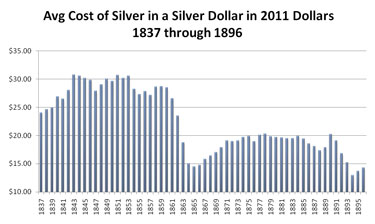With silver’s upward trend in price over the past days, weeks and months, it’s interesting to look back in time to see the values. It’s especially interesting to find what the US Mint paid for the silver in silver dollars back in the early days of the Mint when dollar coins contained silver.
In his book published in 1898, Mr. Evans included a table of the “Bullion value of 371 1/4 grains of pure silver (the amount contained in a silver dollar) at the annual average price of silver each year from 1837 to 1895, inclusive.”
Let’s look at those values in a chart:
It’s interesting to note that in quite a few years “annual average cost” of the silver in a silver dollar was more than a $1.00. Interesting, too, neither the cost of the copper nor the cost of the labor to make the dollars was included. Since the values were an “annual average cost,” let’s hope that the Mint was able to purchase their silver at numbers less than the average such that a dollar coin did not cost more than a dollar to make and to deliver into circulation.
But to grasp how this compares to today, how do these silver values translate into 2011 dollars?
That’s interesting. Due to inflation and consumer price indices changing throughout the years, the charts form different curves. Still, those early years show silver to be valuable. Remember, though, this just represents the amount of silver in a silver dollar which equates to roughly 24.06 grams.
The price we see for silver in the markets is per troy ounce which is roughly 31.1 grams. Let’s look at the price of a troy ounce in these years, 1837-1896, using 2011 dollars.
Today (February 23, 2011), silver closed at $33.54 per ounce. Just look at those values, from 1840 through 1861, silver cost more per troy ounce than it does today.
Looking at history, the Comstock Lode found in Nevada in 1858 probably helped reduce the value. In addition, the Coinage Act of 1857 no longer allowed foreign coins to be used as legal tender. People could turn in some of their foreign coins to be melted and the metal reused.
Remember, too, in the early years of our coinage, our monetary system was based on both gold and silver. In 1873, Congress changed the basis of our monetary system to be only a gold standard. (Of course, many years later, our monetary system would be de-coupled from gold as well.)
With more digging into the history of the time, additional explanations can be found for the pricing and inflation impacts not only to silver but also for the other goods and services of those years. We’ll save that research for another day.
Resources:
Google Books: Illustrated History of the United States Mint


